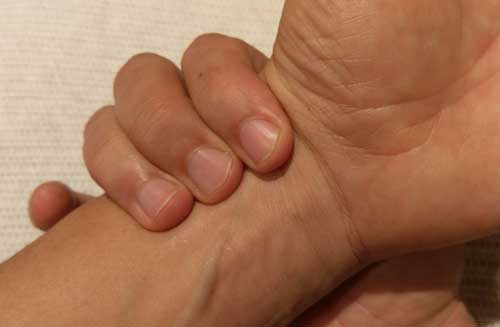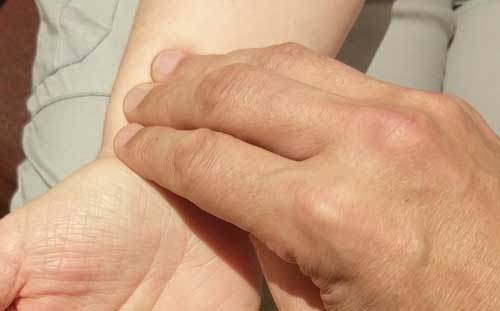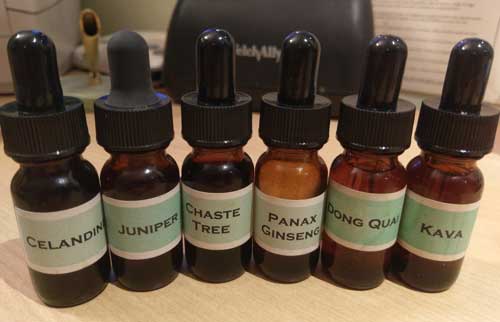
|
|
||
| Our Pages ABOUT CONSTITUTIONAL MEDICINE
|
This article is to share the technique of testing the pulse to determine the response of our 'innate intelligence' to a tiny amount (one or two drops) of a substance taken by mouth. It is especially written with students of holistic medicine in mind but, equally, these notes may be of benefit to the reader who is attempting to take better charge of their health and wishes to seek the help of the intuitive guide that lives within them to help them on their way. As much as the writer, and the other medical herbalists he knows, deeply values the scientific method, pulse testing is all art. Entirely subjective, largely inexplicable, art. Consequently, it will not suit everyone, but if you are willing to start with the premise that 'the heart knows what the heart wants' then pulse testing is likely to make sense to you. Just don't expect a scientific explanation for 'how' the pulse can palpably change within seconds of a person tasting and sensing a herbal medicine! I wanted to get this art vs. science point out in front because I think that, for a person to learn and then apply this method to themselves, that it requires a certain amount of willingness to embrace the unknown and open their heart and mind to the process of simply listening, without expectation, to what happens to the quality and rhythm of their pulse when they take a drop or two of a substance by mouth. Equally, in pulse-testing someone else, you are connecting to their heart, via their pulse, in a way that lets you feel their living, beating 'life-force' and it seems that the person doing the testing must be willing to have a non-judgemental, empty mind and open heart to do it correctly. This does not take any special training, nor is it especially difficult, but it does require a conscious choice to be open, listening, and receptive. Truly, anyone can do it, so long as they are willing to make that choice and, if you are sure you will want to, then read on. It seems that the most important things in life are shrouded in mystery. How did the universe begin? How did life begin? Why are we here? Interwoven with the everyday miracle of existence itself, is an extra-ordinary force, we might call it 'Nature' that exists within every living thing, no matter how tiny. This 'vital force', is never so obvious to us as when we lack it, when we are tired, or sick, or suffering, and yet somehow, often with no action on our part other than to get out of its way, we replenish, heal, and get better, it just happens. Ultimately, it is this remarkable, self-healing, force of Nature that returns us to health and, if it cannot, we must worsen and decline. Consequently, in working for healing, our goal must be to align with this force, to do whatever we can to remove whatever might be obstructing it, to let it do its work. Herbal medicines have been an integral part of our collective journey from our very beginnings. Those roots, flowers, leaves & berries that reliably helped to remove obstacles and nourish the self-healing force have been collected and cherished for as many millennia as we have been able to talk with each other, because the knowledge of when and how to use them has then been carefully passed down through each successive generation. Now, in the modern world, we have relatively easy access to an enormous number of plant medicines, more than ever before. This is a great thing on many levels; herbs are the 'people's medicine'. They belong to all of us just as we belong to the Earth itself. No-one can patent a herb, no-one can take ownership of it, no-one can get exclusive rights to its use and distribution. Much of the motivation behind the labour of love that is this living book has been to empower people with the knowledge and confidence to wisely and safely use these great gifts from Nature for themselves and their loved ones. However, just because the herbs and the knowledge about them is so readily available does not equate to them being safe or appropriate for everyone and anyone to use. Herbs are potent, complex, natural drugs. They are not vitamins, they are not things that we are used to having every day in our foods, they contain strong medicinal substances that our body responds to in diverse ways. There is a great art to using herbal medicines wisely. To knowing firstly what herb to take, but also how much of it to take and how long to take it for. Even how to best combine it with other herbal remedies to speed and enhance its effects. Knowledge is essential, both that which has been passed down through the many generations as well as the knowledge that has been learned through the lens of modern science. However, what works for one person does not always work for another and, by itself, knowledge can at times prove inadequate to the vital task of matching the right herbal allies with the person who is stuck in a condition that is not resolving itself. Sometimes, in the vital matter of choosing what medicine to help, especially in the beginning or when we are thinking about those remedies that have the power to affect our internal chemistry and balance at particularly deep levels, it may be wise to get in touch with, and seek the guidance of that intelligent force, that which runs like a river through all living things and, as all the old cultures and traditions of medicine have known, that which can best be felt and understood at one particular place in the body - the pulse!
Right at the point when we need to get in touch with our innate intelligence, there is the simplest of techniques to help us take a step into the unknown. A technique that is immediately available to anyone, requires no special training or ability, and is as accessible as our ability to touch and feel. Pulse-testing can certainly be used with another, in fact it is often considerably easier to do this someone else than it is do it with yourself. Nevertheless, to learn it well, you must first become familiar with feeling and reading your own pulse. See the picture above to show the best hand position to begin. Hold one hand and wrist in the palm of the other and wrap your fingers around your wrist so that your fingertips lie comfortably over the radial artery, just inside the bone, in line with the base of your thumb. This process of learning how to listen to the pulse is all about waiting, it is about allowing something to come to you rather than trying to go to it, it is about being empty, open and receptive. Take your time, relax, move your fingers around while you are learning how to best find it, explore, go deeper, come back softer, try to get as much contact with the pulse as you can. Ideally, and with practice, you will be able to feel the pulse through three fingers at the same time; your index, middle and ring fingers. Nestle them in close together as if they were all wanting to get in there and have a feel. Don't use the very tips of your fingers, because there are less nerve endings there than in the pads. The best part to use is the top half of where your 'finger-prints' are. Here is where some of the most sensitive tissues of your whole body are present. Those tissues, those nerves, are the ones you want feeling the movement, shape, and 'feel' of your pulse. Note that, when it comes time to try this method with another, you will need to slightly bend up your middle finger so that all three fingers are lined up together, the photo below shows this position. It soon becomes easy to hold the hand in this way with practice. Now, whether you are doing this with yourself, or whether you are doing it with another person, whilst you are holding the pulse and giving your full attention to whatever it is that you are feeling, you simply place one or two or three drops of a herbal tea or tincture, or any other substance for that matter, on to the tongue. Just as you have been using your primal sense of 'touch' to feel the heart's echo beating through the wrist, so you are now going to use the equally remarkable senses of smell and taste to allow the body to feel and process the herb or substance you are introducing to it. Then you listen to what the heart has to say about that herb or substance.
Even though this is art, not science, especially when you are learning this practice, it is recommended that you adopt the mind-set of a scientist who is conducting an experiment. Especially when I began using this 'double-blind' method, I found it required considerable self-discipline to not take a peek but in holding fast I got a great deal more from the process. Keeping the expectations of the mind completely out of the way allows you to simply observe what changes happen when introducing a substance to the body, whilst feeling the pulse before, during, and after. When you do this, emptying the mind of expectation and thus simply listening carefully to whatever it is that you can feel under your fingers, a rather remarkable process unfolds. Within mere seconds of the body tasting, smelling and feeling the drops of herbs that have gone within, the heart shows its response, and you can feel it through the pulse. You will sometimes observe how the strength and vigour of the pulse may fade away or become somehow irregular. Sometimes one can feel a kind of 'edge' or a tension in the pulse, it becomes palpably 'raggedy'. After just a little practice and experience, you will begin to easily feel these reactions because they are quite unmistakable, and they clearly show that this herb or other substance is not what is wanted or required just now. To be honest, I love to get such clearly 'negative' responses. They are telling me in no uncertain terms that the heart is talking to me and that it knows what it wants. The last thing in the world I want to do is to break the first rule; primum non nocere, 'firstly, do no harm!'. Our body is like a living laboratory, thousands of complex chemical reactions occur within it every day we are alive. We should never underestimate its innate intelligence including that the heart really does know what the heart wants; if it says no, listen to it! It is also highly likely that there will be at least one remedy, and usually a few, for which the opposite reaction will occur, Many, many times, when introducing a new herb to a person there will be a moment's pause as the body feels, senses and processes this new visitor, and then the heart most palpably 'lifts'. The pulse becomes stronger, fuller, smoother, more 'rounded'. The vital force, the healing intelligence, speaks through the heart, it says 'yes!' You must consider some practicalities in doing pulse testing, i.e. in the way you set up the drops of the medicine to be conveniently tested whilst one of your hands is otherwise engaged! It is very important that you are in touch with the pulse throughout the whole process, before, during and after. You will be able to get the basic technique with a little practice and then, of course, the more you practice it, the easier it gets. Perhaps surprisingly, it is less common to get a completely neutral 'non-reaction' as it is to get something that is more obviously a yes or no, but such indifferent reactions will happen and don't need to be over-analysed, just make a mental or written note and pass on to the next one.
There is good reason that all the ancient, great traditions of medicine have put so much store by the pulse. You can immediately feel a person's vital force through their pulse, its rhythm and flow are like a meeting point of the mind and body. You can feel the nerves, the energy, and the will to be well. In my own practice, I have found pulse testing to be of the greatest value when seeking a surety for one of our especially potent medicines, for example a cleansing remedy, or a herb that affects the hormones, or the mind, or some vital organ. How marvellous that we have an inherent, natural intuition that allows us to fathom friend from foe, what might especially help us, what might do us harm. Anyone who is seeking to work with the force of Nature will find that, if they are willing to ask open questions, and to wait and listen, that it will gladly and clearly respond.
On a closely related topic, aside from using the pulse to test things, if you are interested to learn more about pulse diagnosis in general, there is a further article on this subject found here Please understand that I cannot personally advise you without seeing you in my clinic. |
|
|
|
© 2011 R.J.Whelan Ltd



